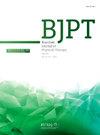Immersive virtual reality versus cervical mobilization: The effects on joint position sense and pain for chronic neck pain - a randomized controlled trial
IF 3.2
3区 医学
Q1 ORTHOPEDICS
引用次数: 0
Abstract
Background
Joint position sense (JPS) deficits and pain are among symptoms observed in patients with chronic neck pain (CNP).
Objective
To examine the effects of immersive virtual reality (VR) and cervical mobilization (CM) on JPS and pain in patients with CNP.
Methods
This randomized controlled study included 45 patients with CNP, aged 18 to 65. Patients were divided into three groups: VR+traditional exercise, CM+traditional exercise, and traditional exercise alone. The primary outcomes were JPS and pain. The secondary outcomes were balance, functional disability, global perceived effect, and quality of life. Balance outcomes included baropodometric outcomes, 10-meter walking test, four-square step test, and single leg stance test. All patients completed 10 treatment sessions, with outcomes measured before and after the intervention.
Results
There were no statistically significant additional effects of VR or CM on improving JPS or pain relief when added to traditional exercises (p > 0.05). The changes in all balance outcomes, functional disability, and global perceived effect were also similar for the three groups (p > 0.05). The combination of CM or VR and traditional exercises resulted in greater improvement in social function quality of life compared to traditional exercises alone (MD = 21.15, 95 % CI: 9.46, 32.85, Cohen’s d = 1.52).
Conclusion
The addition of VR or CM to traditional exercises offers no additional benefits for JPS, pain, balance, and function, for individuals with CNP.
沉浸式虚拟现实与颈椎活动:慢性颈部疼痛对关节位置感和疼痛的影响-一项随机对照试验
关节位置感(JPS)缺陷和疼痛是慢性颈部疼痛(CNP)患者的症状之一。目的探讨沉浸式虚拟现实(VR)和颈椎活动(CM)对CNP患者JPS和疼痛的影响。方法随机对照研究纳入45例CNP患者,年龄18 ~ 65岁。患者分为VR+传统运动、CM+传统运动、单独进行传统运动三组。主要结局为JPS和疼痛。次要结局是平衡、功能障碍、整体感知效应和生活质量。平衡结果包括足压测量结果、10米步行测试、四方步测试和单腿站立测试。所有患者都完成了10次治疗,并在干预前后测量了结果。结果在传统运动中加入VR或CM对改善JPS或缓解疼痛的额外作用无统计学意义(p >;0.05)。所有平衡结果、功能障碍和整体感知效应的变化在三组中也相似(p >;0.05)。与单独进行传统运动相比,CM或VR与传统运动相结合对社会功能生活质量的改善更大(MD = 21.15, 95% CI: 9.46, 32.85, Cohen’s d = 1.52)。结论在传统运动的基础上增加VR或CM对CNP患者的JPS、疼痛、平衡和功能没有额外的好处。
本文章由计算机程序翻译,如有差异,请以英文原文为准。
求助全文
约1分钟内获得全文
求助全文
来源期刊
CiteScore
6.10
自引率
8.80%
发文量
53
审稿时长
74 days
期刊介绍:
The Brazilian Journal of Physical Therapy (BJPT) is the official publication of the Brazilian Society of Physical Therapy Research and Graduate Studies (ABRAPG-Ft). It publishes original research articles on topics related to the areas of physical therapy and rehabilitation sciences, including clinical, basic or applied studies on the assessment, prevention, and treatment of movement disorders.

 求助内容:
求助内容: 应助结果提醒方式:
应助结果提醒方式:


